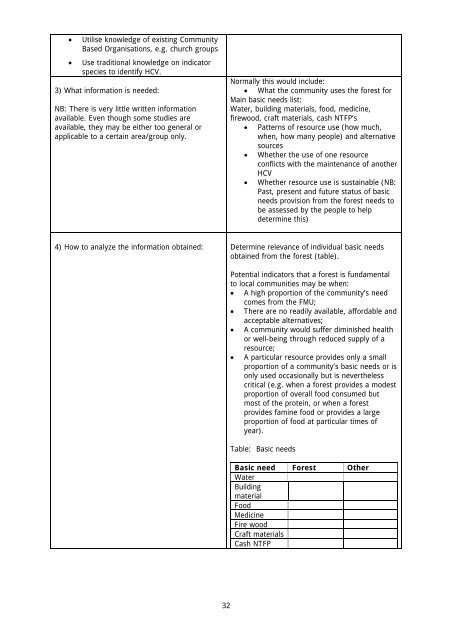A National Interpretation of the High Conservation Value Forest ...
A National Interpretation of the High Conservation Value Forest ...
A National Interpretation of the High Conservation Value Forest ...
Create successful ePaper yourself
Turn your PDF publications into a flip-book with our unique Google optimized e-Paper software.
• Utilise knowledge <strong>of</strong> existing Community<br />
Based Organisations, e.g. church groups<br />
• Use traditional knowledge on indicator<br />
species to identify HCV.<br />
3) What information is needed:<br />
NB: There is very little written information<br />
available. Even though some studies are<br />
available, <strong>the</strong>y may be ei<strong>the</strong>r too general or<br />
applicable to a certain area/group only.<br />
Normally this would include:<br />
• What <strong>the</strong> community uses <strong>the</strong> forest for<br />
Main basic needs list:<br />
Water, building materials, food, medicine,<br />
firewood, craft materials, cash NTFP’s<br />
• Patterns <strong>of</strong> resource use (how much,<br />
when, how many people) and alternative<br />
sources<br />
• Whe<strong>the</strong>r <strong>the</strong> use <strong>of</strong> one resource<br />
conflicts with <strong>the</strong> maintenance <strong>of</strong> ano<strong>the</strong>r<br />
HCV<br />
• Whe<strong>the</strong>r resource use is sustainable (NB:<br />
Past, present and future status <strong>of</strong> basic<br />
needs provision from <strong>the</strong> forest needs to<br />
be assessed by <strong>the</strong> people to help<br />
determine this)<br />
4) How to analyze <strong>the</strong> information obtained: Determine relevance <strong>of</strong> individual basic needs<br />
obtained from <strong>the</strong> forest (table).<br />
Potential indicators that a forest is fundamental<br />
to local communities may be when:<br />
• A high proportion <strong>of</strong> <strong>the</strong> community’s need<br />
comes from <strong>the</strong> FMU;<br />
• There are no readily available, affordable and<br />
acceptable alternatives;<br />
• A community would suffer diminished health<br />
or well-being through reduced supply <strong>of</strong> a<br />
resource;<br />
• A particular resource provides only a small<br />
proportion <strong>of</strong> a community’s basic needs or is<br />
only used occasionally but is never<strong>the</strong>less<br />
critical (e.g. when a forest provides a modest<br />
proportion <strong>of</strong> overall food consumed but<br />
most <strong>of</strong> <strong>the</strong> protein, or when a forest<br />
provides famine food or provides a large<br />
proportion <strong>of</strong> food at particular times <strong>of</strong><br />
year).<br />
Table: Basic needs<br />
Basic need <strong>Forest</strong> O<strong>the</strong>r<br />
Water<br />
Building<br />
material<br />
Food<br />
Medicine<br />
Fire wood<br />
Craft materials<br />
Cash NTFP<br />
32

















